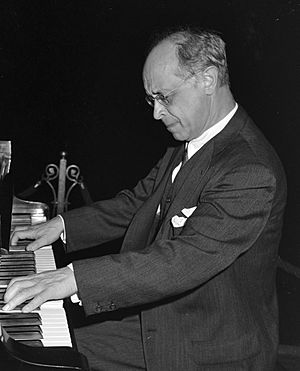Rudolf Serkin facts for kids
Rudolf Serkin (born March 28, 1903 – died May 8, 1991) was an amazing pianist. He was born in Bohemia (which is now part of the Czech Republic) and later became an American citizen. Many people think he was one of the best musicians to play the works of Ludwig van Beethoven in the 20th century.
Contents
Early Life and Musical Start
Rudolf Serkin was born in a town called Eger, which is now known as Cheb. This was in the Kingdom of Bohemia, part of the Austro-Hungarian Empire at the time. His family was Russian Jewish. His father, Mordko Serkin, was a singer who taught Rudolf to read music even before he could read words!
Rudolf was seen as a child prodigy, meaning he was super talented from a young age. When he was just 9 years old, he went to Vienna to study piano with Richard Robert. Later, he studied how to compose music with Joseph Marx. He played his first public concert at age 12 with the famous Vienna Philharmonic orchestra.
Learning and Performing in Europe
From 1918 to 1920, Rudolf studied composition with Arnold Schoenberg. He also took part in Schoenberg's special music society. In 1920, he started his regular concert career. He lived in Berlin with the German violinist Adolf Busch and his family. Busch had a young daughter named Irene, who Rudolf would marry 15 years later.
In 1921, when he was 17, Rudolf played his first concert in Berlin. He performed with Busch's group, playing the keyboard part in the Brandenburg Concerto No. 5. After the concert, Busch told Rudolf to play an extra piece for the excited audience. Rudolf later said he asked Busch, "What should I play?" Busch jokingly told him to play the very long Goldberg Variations. Rudolf took him seriously and played the whole thing! By the time he finished, only four people were left in the audience: Adolf Busch, Artur Schnabel, Alfred Einstein, and Rudolf himself.
Throughout the 1920s and early 1930s, Rudolf Serkin performed all over Europe. He played as a solo artist and also with Adolf Busch and the Busch Quartet.
Moving Due to World Events
When Adolf Hitler and the Nazi party came to power in Germany in 1933, Rudolf and the Busches decided to leave. Even though the Busches were not Jewish, they strongly disagreed with the Nazi government. They moved from Berlin to Basel, Switzerland.
In 1933, Rudolf made his first appearance in the United States at a festival in Washington, D.C. He performed there with Adolf Busch. In 1936, he started his solo concert career in the US. He played with the New York Philharmonic orchestra, led by Arturo Toscanini. Critics loved his playing, saying he had "a clear technique, lots of power, delicacy, and pure sound." In 1937, Rudolf played his first solo concert in New York City at Carnegie Hall.
Life in the United States
Soon after World War II began in 1939, the Serkin and Busch families moved to the United States. Rudolf Serkin became a teacher at the Curtis Institute of Music in Philadelphia. He taught many generations of pianists there. From 1968 to 1976, he was even the director of the Institute.
He lived with his growing family first in New York, then in Philadelphia, and also on a dairy farm in rural Guilford, Vermont.
Marlboro Music Festival
In 1951, Rudolf Serkin and Adolf Busch started the Marlboro Music School and Festival in Marlboro, Vermont. Their goal was to get more people interested in and playing chamber music (music for small groups of instruments) in the United States.
Rudolf made many recordings from the 1940s into the 1980s. One famous recording was of Ludwig van Beethoven's Piano Concerto No. 4 in 1944. He recorded it with the NBC Symphony Orchestra and Toscanini. Most of his recordings were for Columbia Masterworks, but later he also recorded for Deutsche Grammophon and Telarc. Rudolf really admired the music of Max Reger. In 1959, he was the first pianist in the United States to record Reger's Piano Concerto.
Achievements and Family
Rudolf Serkin received the Presidential Medal of Freedom in 1963. In March 1972, he celebrated his 100th performance with the New York Philharmonic. He played Johannes Brahms' Piano Concerto No. 1. The orchestra also made him an honorary member, a special award given to only a few great musicians like Aaron Copland and Igor Stravinsky. In 1986, he celebrated 50 years of being a guest artist with the orchestra. He is still known as one of the best players of Beethoven's music in the 20th century.
Rudolf was highly respected by other musicians. He was like a father figure to many younger players who came to the Marlboro School and Festival. He was known for his strong musical honesty. He traveled and performed all over the world. He continued his solo career and recording until he became too ill to work in 1989. He passed away from cancer on May 8, 1991, at the age of 88, at his farm in Guilford, Vermont.
Rudolf and Irene had seven children, though one died when very young. Their children included the pianist Peter Serkin and the cellist Judith Serkin. They also had fifteen grandchildren, including the composer David Ludwig. Irene Busch Serkin passed away in 1998.
Awards and Special Honors
Rudolf Serkin received many important awards for his contributions to music:
- Presidential Medal of Freedom (1963) - This is one of the highest awards a civilian can receive in the United States.
- Ernst von Siemens Music Prize (1978) - A major international music award.
- Kennedy Center Honors (1981) - Celebrates lifetime contributions to American culture.
- Grammy Award for Best Chamber-Music Performance (1984) - He won this with Mstislav Rostropovich for playing Brahms' Cello Sonatas.
- National Medal of Arts (1988) - Another high honor for artists in the United States.
See also
In Spanish: Rudolf Serkin para niños


